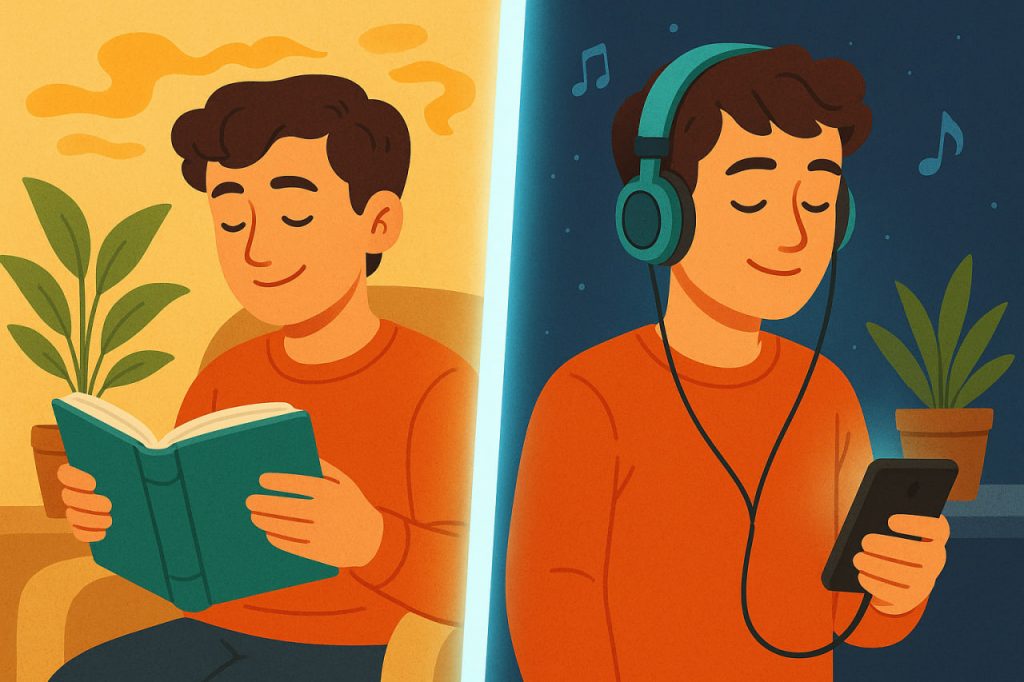In the digital age, the way people consume knowledge has expanded beyond printed pages. Audiobooks have become increasingly popular, offering a convenient alternative to traditional reading. But does listening to a book have the same cognitive and emotional benefits as reading it? The answer is nuanced — both methods activate the brain differently and serve unique purposes depending on context, learning style, and goals.
How the Brain Processes Reading and Listening
When we read, our brains engage the visual cortex, which decodes written symbols into words and meaning. This process also activates the language centers — mainly Broca’s area (speech production) and Wernicke’s area (language comprehension). Reading silently forces the brain to visualize information, improving focus, imagination, and memory retention.
When we listen to a book, the auditory system takes over. The temporal lobes process sounds and tone, allowing us to understand the meaning and emotion behind spoken words. Interestingly, studies show that the same brain regions responsible for comprehension are active during both reading and listening — but the intensity and focus differ.
In short, reading is more visually immersive, while listening is more emotionally engaging.
The Advantages of Reading Books
- Deeper Concentration and Understanding:
Reading requires active attention, which strengthens focus and comprehension. Readers often pause, reflect, or reread sections to grasp complex ideas. - Better Memory Retention:
Visual reading activates memory pathways that help store information longer. The act of scanning text and turning pages reinforces cognitive mapping — the mental “layout” of ideas. - Improved Vocabulary and Writing Skills:
Seeing words in context enhances spelling, grammar, and sentence structure awareness — something listening cannot replicate as effectively. - Mental Visualization:
Reading stimulates imagination, forcing the mind to create images and emotional tone — a powerful exercise for creativity and empathy. - Reduced Distractions:
Reading often occurs in quiet, focused environments, reducing the chance of multitasking compared to listening.
The Advantages of Listening to Books
- Multitasking and Flexibility:
Audiobooks allow people to absorb information while walking, driving, or exercising — turning idle time into learning time. - Emotional Expression:
A skilled narrator can bring characters to life through tone, pacing, and emotion. This can deepen engagement, especially with fiction or storytelling. - Accessibility:
Audiobooks are invaluable for individuals with dyslexia, visual impairments, or reading difficulties, ensuring that literature remains inclusive. - Listening Comprehension Development:
Listening trains the brain to detect patterns, intonation, and nuance in speech, improving conversational understanding. - Stress Reduction:
Many listeners report that audiobooks have a calming effect, similar to meditation or music, especially before sleep or during commutes.
Which Is Better for Learning?
The answer depends on purpose. If the goal is deep learning or study, reading is usually superior because it allows for note-taking, highlighting, and visual memory. However, for general knowledge, relaxation, or storytelling, audiobooks can be just as beneficial.
Research from the University of California found that comprehension between reading and listening is nearly identical for straightforward narratives but differs for complex or technical texts, where visual structure aids understanding.
The Ideal Approach: Combining Both
Many experts suggest blending reading and listening — a method known as “immersive reading.” This involves listening to an audiobook while following the printed or digital text. Studies show this dual approach enhances comprehension and retention by activating multiple sensory pathways simultaneously.
For example, listening while reading can help language learners associate pronunciation with spelling or help busy professionals absorb more content efficiently.
The Psychological and Emotional Dimension
Reading tends to foster introspective focus — an inward journey through ideas and imagination. Listening, on the other hand, encourages emotional connection through voice and tone. Both are forms of mindfulness — one visual, the other auditory — and each contributes to mental well-being.
Interesting Facts
- The first audiobook recordings appeared in the 1930s, created for visually impaired readers.
- Listening activates the brain’s mirror neurons, helping people emotionally connect with characters.
- Readers typically remember where information appeared on a page, creating a spatial memory map.
- People who both read and listen to books tend to finish 25% more titles per year on average.
Glossary
- Comprehension — the ability to understand and interpret meaning.
- Cognitive mapping — mental representation of information or spatial layout.
- Immersive reading — combining audio and visual reading for deeper engagement.
- Mirror neurons — brain cells that activate when observing or empathizing with others.
- Auditory cortex — the brain region responsible for processing sound and language.


